
设计单位 Andrés Jaque / Office for Political Innovation
项目地点 西班牙马德里
项目时间 2022年
建筑面积 约5496平方米
校园的设计理念是通过建筑环境来激发孩子们探索的欲望。由此,这座建筑也被视作一个复杂的生态系统,让学生能够通过自发的共同试验,来主导自己的教育,这也遵循了Loris Malaguzzi与意大利雷焦艾米利亚市的父母们所提出的教育理念,旨在增强儿童应对不可预测的挑战及潜在风险时的能力。
The design of Reggio School is based on the idea that architectural environments can arouse in children a desire for exploration and inquiry. In this way the building is thought of as a complex ecosystem that makes it possible for students to direct their own education through a process of self-driven collective experimentation— following pedagogical ideas that Loris Malaguzzi and parents in the Italian city of Reggio nell’Emilia developed to empower children’s capacity to deal with unpredictable challenges and potentials.
建筑的设计、建造和使用,都欲在超越可持续发展的既有范式,将生态作为一种手段,将环境影响、生物群落、资源调配、集体治理、教学方式通过建筑来进行交融整合。
The design, construction and use of this building is intended to exceed the paradigm of sustainability to engage with ecology as an approach where environmental impact, more-than-human alliances, material mobilization, collective governance and pedagogies intersect through architecture.


垂直叠加的多元自教育空间
为避免同质化与标注的统一化,校园建筑被打造成一个“多元宇宙”。在这里,环境的分层复杂性将变得可读、可感,就像走进一个不同气候、生态系统、建筑传统与规律的集合体。
Avoiding homogenization and unified standards, the architecture of the school aims to become a multiverse where the layered complexity of the environment becomes readable and experiential. It operates as an assemblage of different climates, ecosystems, architectural traditions, and regulations.

建筑的垂直空间始于与地形相接的首层,这里也是低年级学生们的教室。在此之上较高的楼层,是中年级学生的教室及容纳再生水与土壤的箱体,这些箱体滋养着一个通高温室结构下的室内花园。高年级的教室则围绕着这个室内花园来布置,形成了小村庄般的空间氛围。这种垂直化的布局也隐喻着一个持续成长的过程,在与同伴一起探索校园生态系统中,这一过程最后也将转化成学生们不断增长的能力。
Its vertical progression begins with a ground floor engaged with the terrain, where classrooms for younger students are placed. Stacked on top of this, the higher levels are where students in intermediate classes coexist with reclaimed water and soil tanks that nourish an indoor garden reaching the uppermost levels under a greenhouse structure. Classrooms for older students are organized around this inner garden, as in a small village. This distribution of uses implies an ongoing maturity process that is translated into the growing capacity of students to explore the school ecosystem on their own and with their peers.


容纳多物种的校园核心
二楼是个巨大的空间,通过景观尺度的拱门向周边的生态系统开放,被视为学校主要的社交广场。在这里,师生被鼓励参与到学校的管理,并与周围的景观及土地互动。
The second floor, formalized as a large void opened through landscape-scale arches to the surrounding ecosystems, is conceived as the school’s main social plaza. Here the architecture encourages teachers and students to participate in school government and to interact with the surrounding landscapes and territories.

这一5000英尺(约465平方米)的半封闭中心区域,邻近村庄圣栎树的香气蔓延其间,空间的高度超过了26英尺(约7.9米),被打造成了一个国际化的市集。由生态学家与土壤学家组成的团队,还设计了专用于容纳与培育爬虫、蝴蝶、鸟类和蝙蝠的小花园。在这里,除了日常的锻炼活动,还同时进行着讨论活动,商讨关于如何将这所学校作为一个社区来运营,以及如何与附近的溪流、田野建立连接。最终,这层作为超越人类的多物种的空间持续运营,师生们可以在此感受与适应他们所属的生态系统。
This 5,000 square-feet central area is over 26-feet high and conceived of as a cosmopolitical agora; a semi-enclosed space crisscrossed by the air tempered by the holm oak trees from the neighboring countryside. A network of ecologists and edaphologists designed small gardens specifically made to host and nurture communities of insects, butterflies, birds and bats. Here, mundane activities like exercising coexist with discussions about how the school is run as a community and what is the way to relate to the neighboring streams and fields. Ultimately, this floor operates as a more-than-human summiting chamber where students and teachers can sense and attune to the ecosystems they are part of.

让直观的机械系统参与教学活动
不同于隐藏机械系统的常规设计,这座建筑中所有的设备系统都暴露在外,直观可见,毫不掩饰地让管道、电线、格栅成为视觉与物质生态系统的一部分。如此一来,保持建筑活力的流动系统,将激发学生去思考如何依靠水、能量及空气的交换循环,来维持身体与社会互动。
As an alternative to architecture’s common efforts to hide mechanical systems, here all services are kept visible, so that the flows that keep the building active become an opportunity for students to interrogate how their bodies and social interactions depend on water, energy, and air exchanges and circulations. The building unapologetically allows pipes, conduits, wires and grilles to become part of its visual and material ecosystem.

轻薄、去包覆与蓬松化的环境策略
在南欧,高科技的可持续解决方案仅适用于高预算、企业或国家推广级的建筑。而在这次的校园设计中,建筑依据以下4项原则,制定出低预算的战略体系,以减少其环境足迹:
In the context of Southern Europe, where high-tech sustainable solutions are only available to high-budgeted, corporate or state-promoted buildings, this building develops a low budget strategy to reduce its environmental footprint based on the following design principles:
1)减少土地占用的垂直设计:不同于近90%的校园设计,雷吉奥学校没有选择水平向的占地策略,而是设计成为一座紧凑的垂直建筑。这一设计决策最大限度地减少了建筑的占地面积,优化了对地基的整体需求,并从根本上降低了建筑的立面率。
Verticality to reduce land Instead of opting for a horizontally- expanding land-occupation – as is the case for 90% of school designs – Reggio School is a compact vertical building. This design decision minimizes the building’s footprint, optimizes the overall need for foundations, and radically reduces its façade rate.
2)大幅减少施工量:建筑不设包层、吊顶、架高地板,也没有墙衬和通风立面,仅通过简单的隔热与机械系统来替换掉大部分构造元素,这一举措让建筑立面、屋顶和内部隔断的耗材总量减少了48%。项目最后呈现为一座裸露的建筑,未经修饰的运行组件也定义了建筑的独特美感。
Radical reduction of the No claddings, no drop ceilings, no raised technical floors, no wall lining, no ventilated façades are used in this building. The overall amount of material used in the facades, roofs and interior partitions of the building has been reduced by 48% just by replacing a big part of the construction by simple strategies or thermal insulation and mechanical systems distribution. The result presents a naked building where the non-edited visibility of its operating components defines its aesthetics.

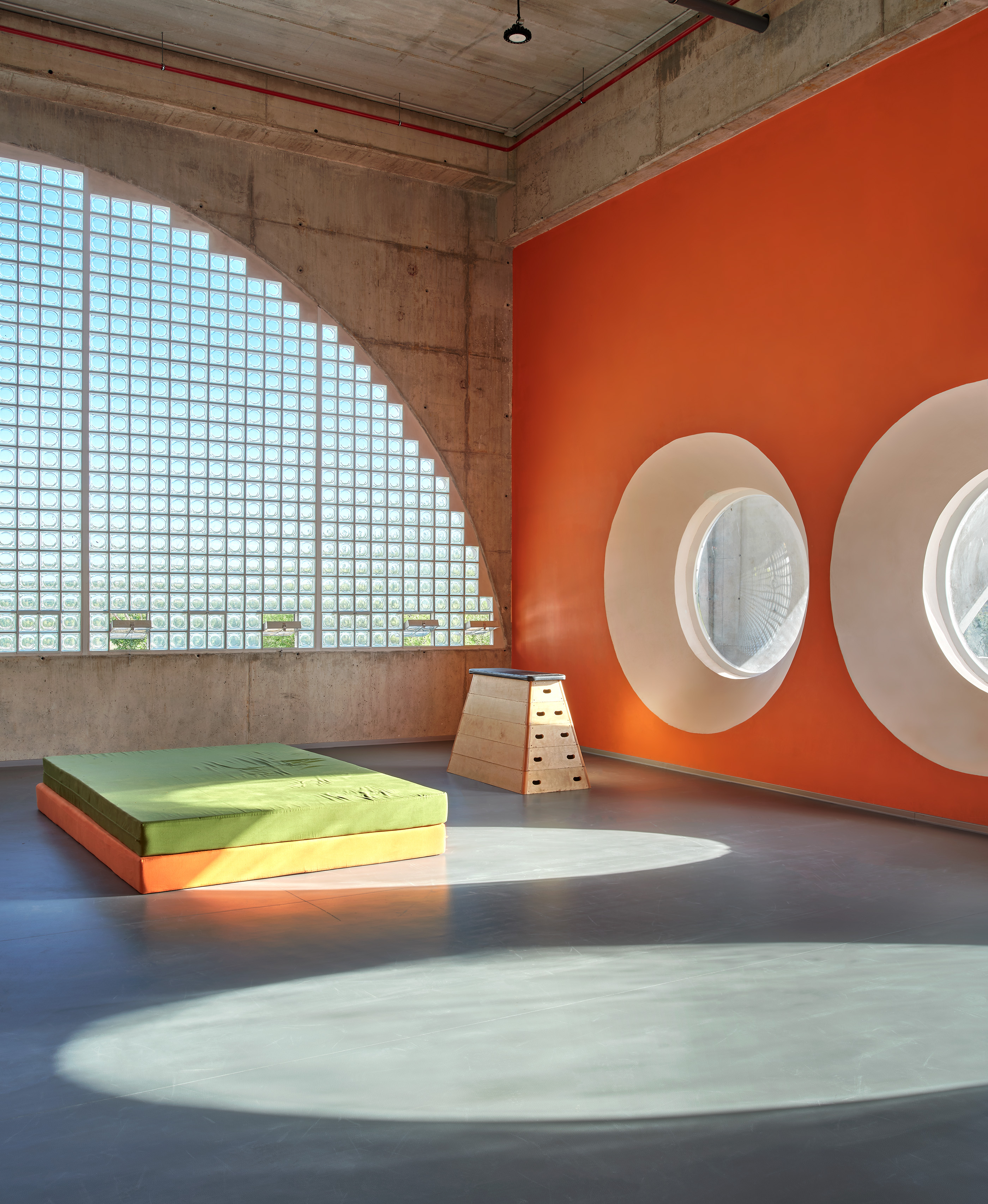
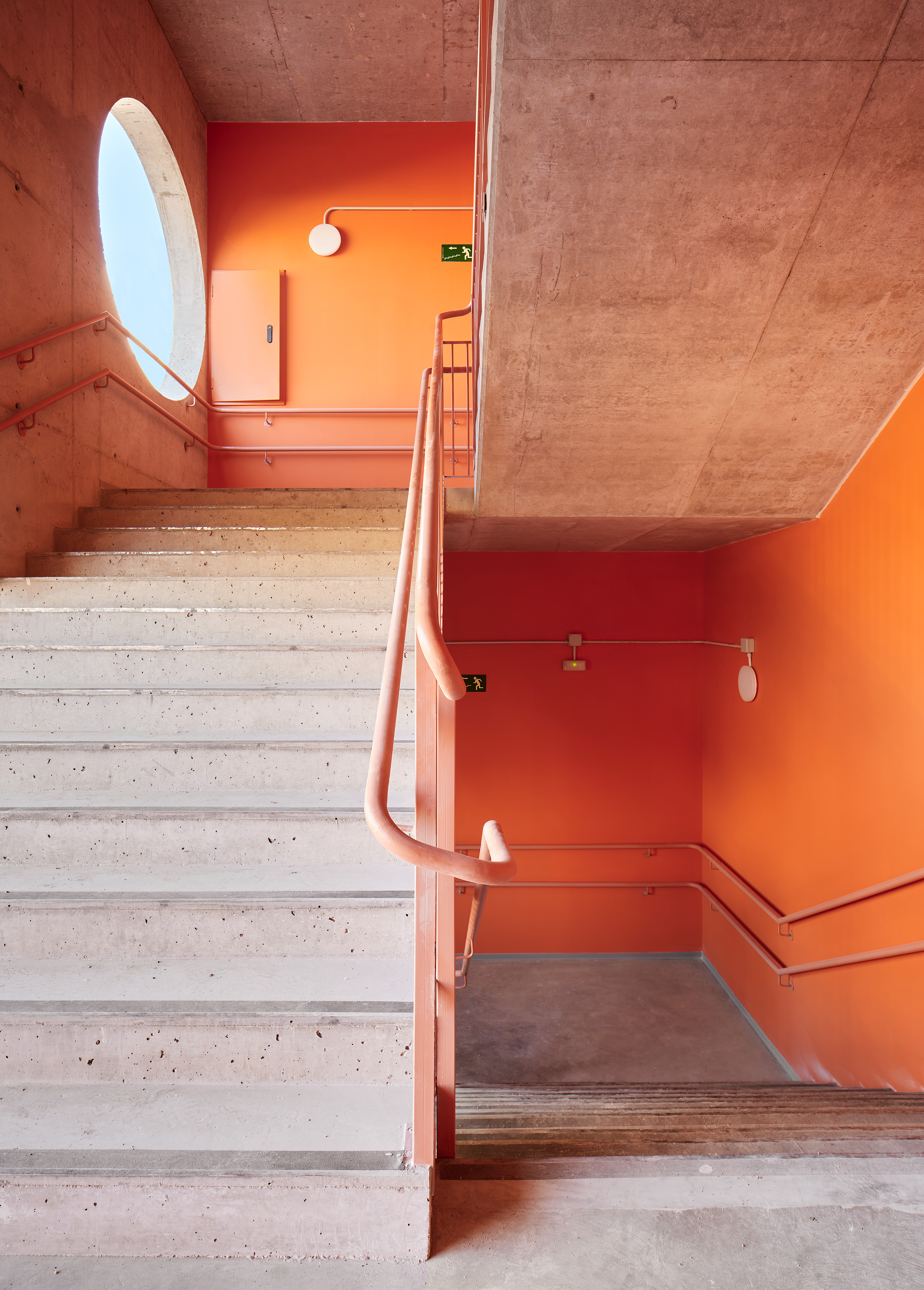
3)厚厚包裹的隔离层:软木覆层既可以隔热,又可以支持人类以外的其他物种的生活。建筑80%的围护结构外都包覆着14.2厘米厚、估测重达9700千克/立方米的致密软木。这一自然的解决方案由事务所为项目专门开发,用于建筑物垂直与倾斜部分的外立面,以提供 R-23.52 等级的隔热性能,这比马德里当地的法规要求还要高出一倍,可令学校在内部供暖期间通过被动手段减少50%的能耗。此外,软木突出部分的不规则表面旨在让有机物质积聚,因此,建筑的围护结构最终将成为多种真菌等微生物、植物和动物的栖息地。
A thick wrapping of living isolation. Cork wrapping as both thermal isolation and support to more-than-human life. 80% of the envelope of the building is externally covered by a 2 cm of projected 9,700 Kg/m3 dense cork. This natural solution, specifically developed by the Office for Political Innovation for this project, is used both in vertical and pitch parts of the building’s external volume to provide a thermal isolation of R-23.52, double that what Madrid’s regulations require. This adds to the passive 50% reduction of consumed energy when heating of the school’s interiors. Beyond this, the irregular surface of the cork projection is designed to allow organic material to accumulate, so that the envelope of the building will eventually become the habitat of numerous forms of microbiological fungi, vegetal and animal life.
4)更多的思考,更少的材料:在研究员兼结构工程师Iago González Quelle的带领下,团队对建筑的结构进行了塑形、分析和尺寸测算,与传统的钢筋混凝土结构相比,承重墙的厚度平均减少了150毫米以上。总体而言,这意味着建筑物结构的内嵌能量可减少有33%。
More thinking, less material. Led by researcher and structural engineer Iago González Quelle, the team has shaped, analyzed and dimensioned the building’s structure so that the thickness of loading walls can be reduced an average of more than 150 mm compared to conventional reinforced concrete Overall, this implied a 33% reduction in the embedded energy of the building’s structure.
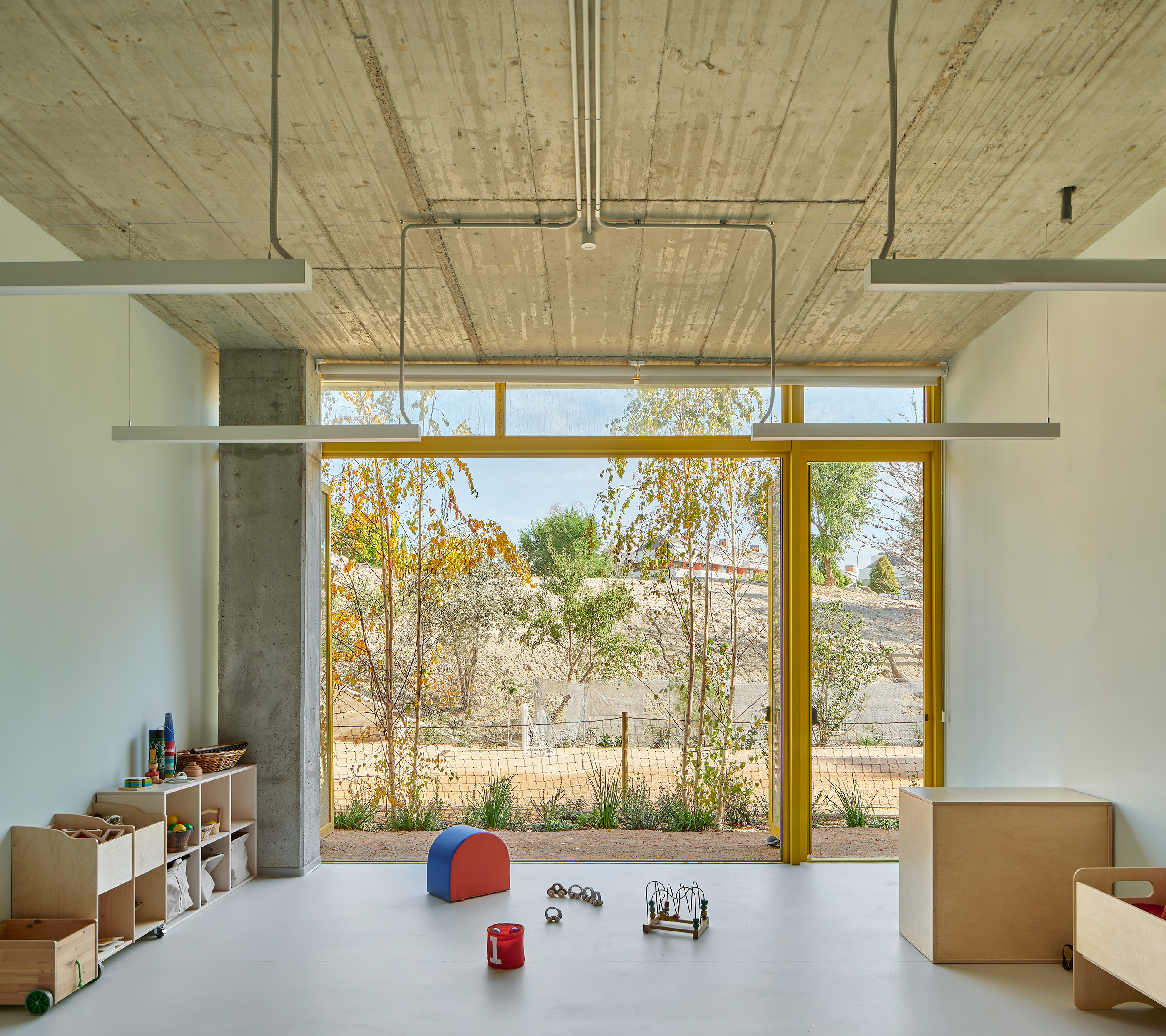
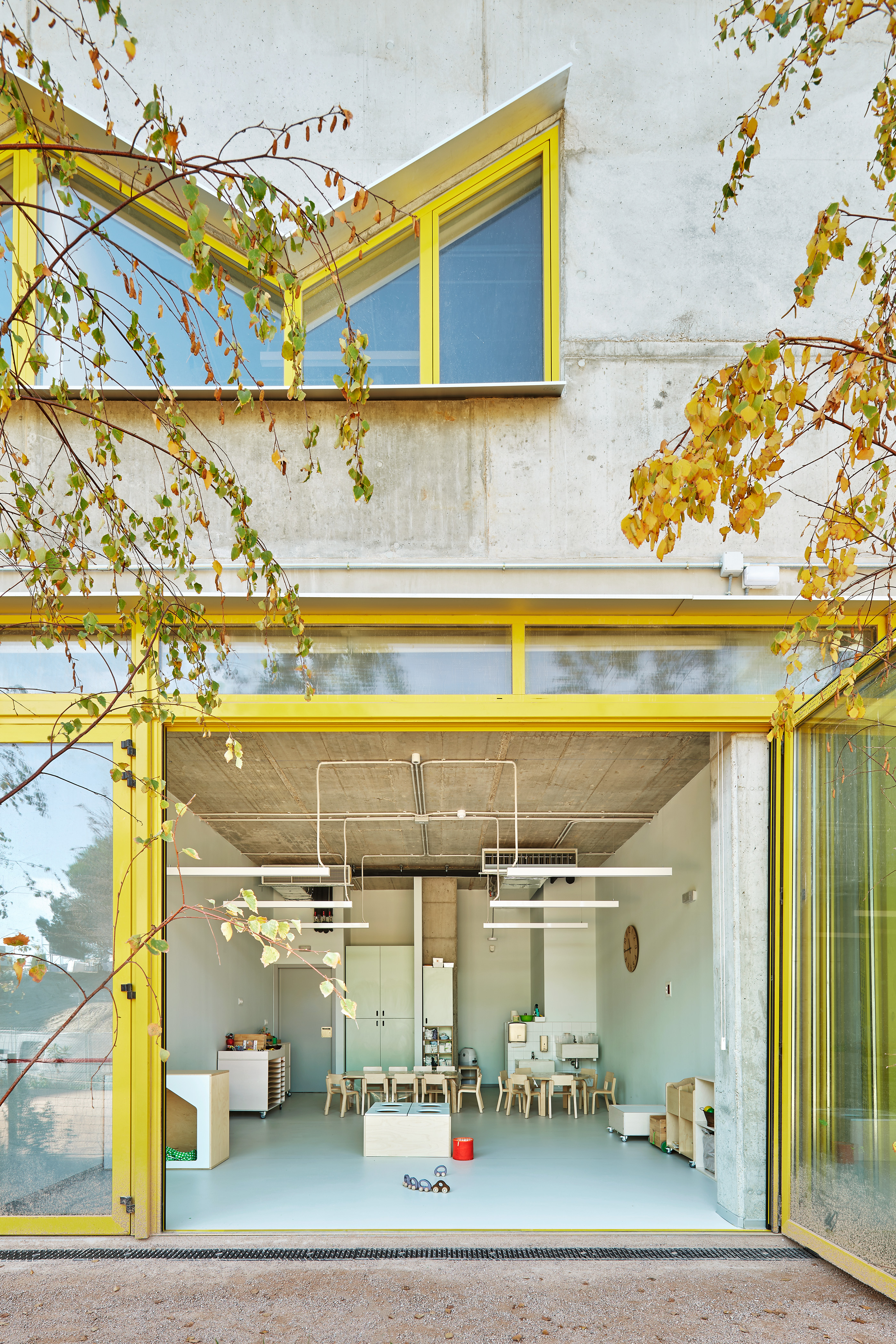
设计图纸 ▽
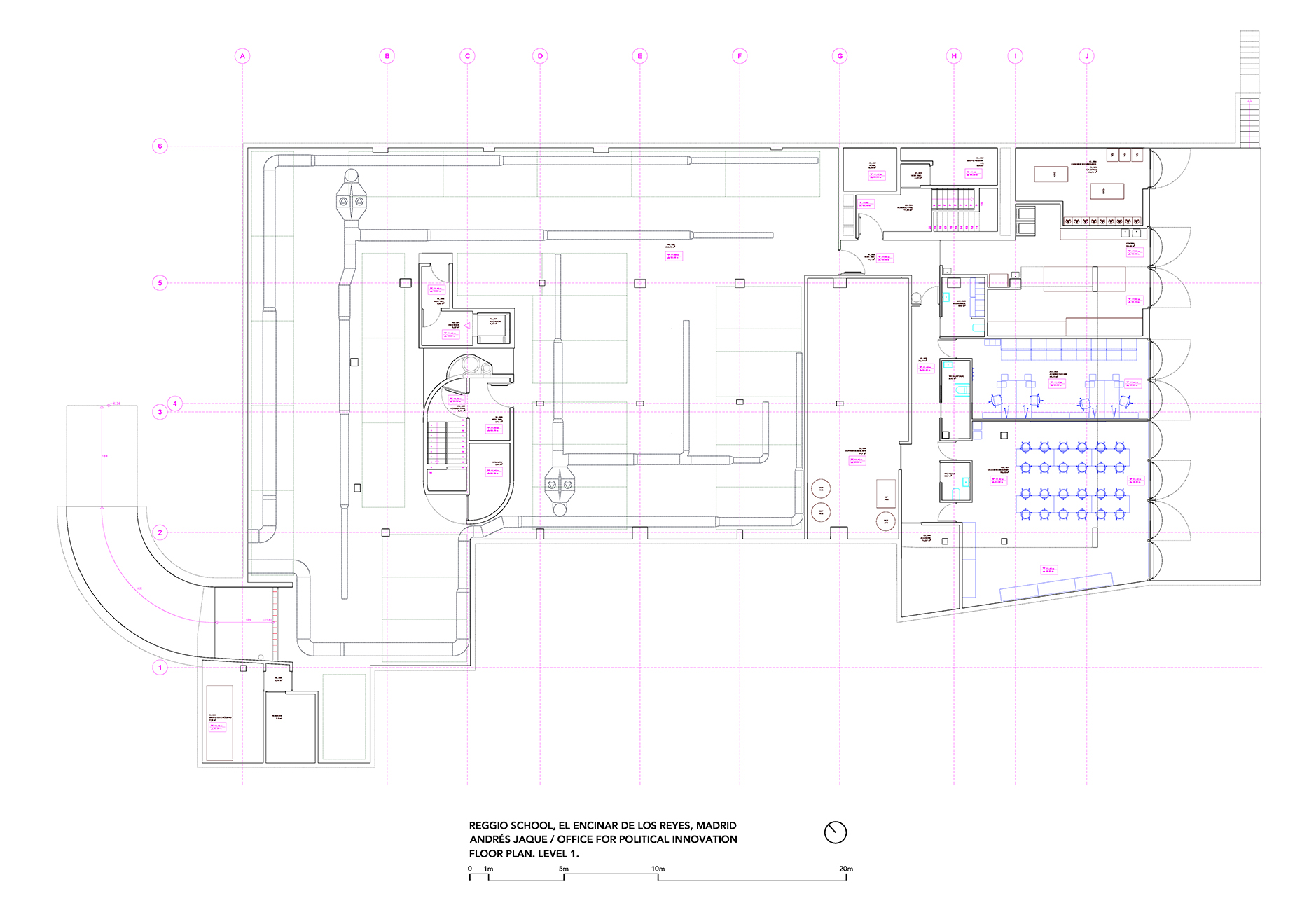



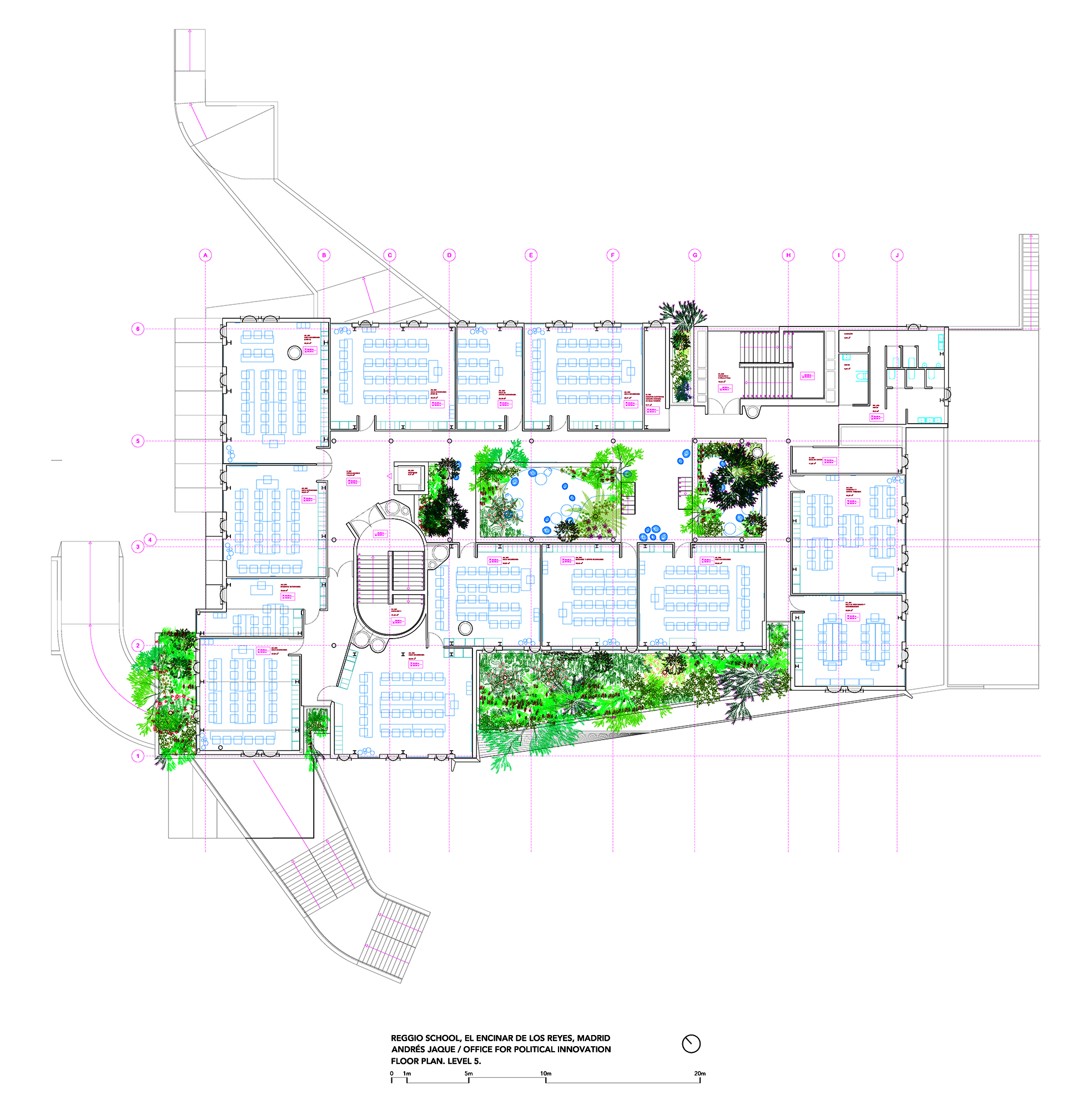
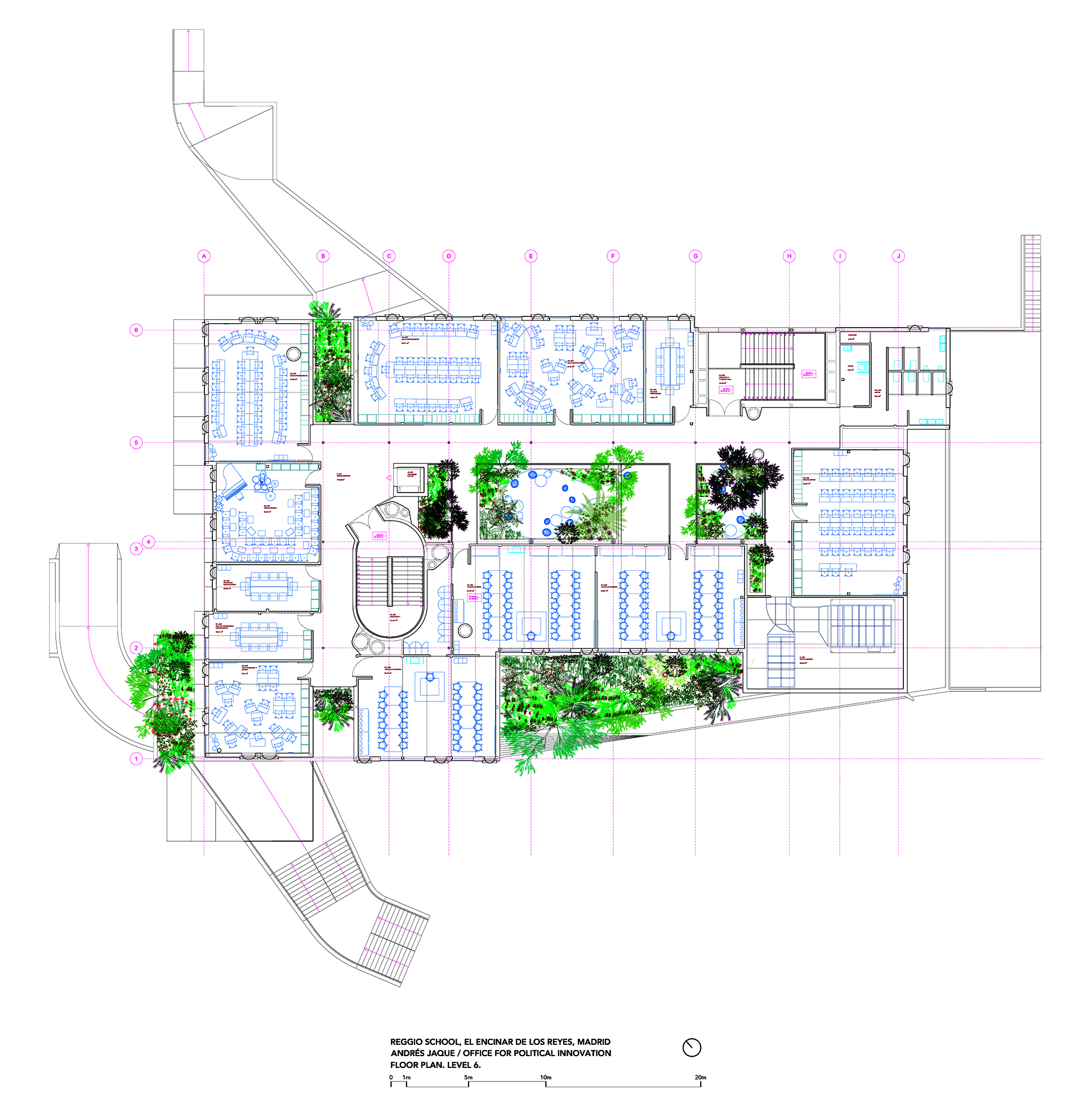
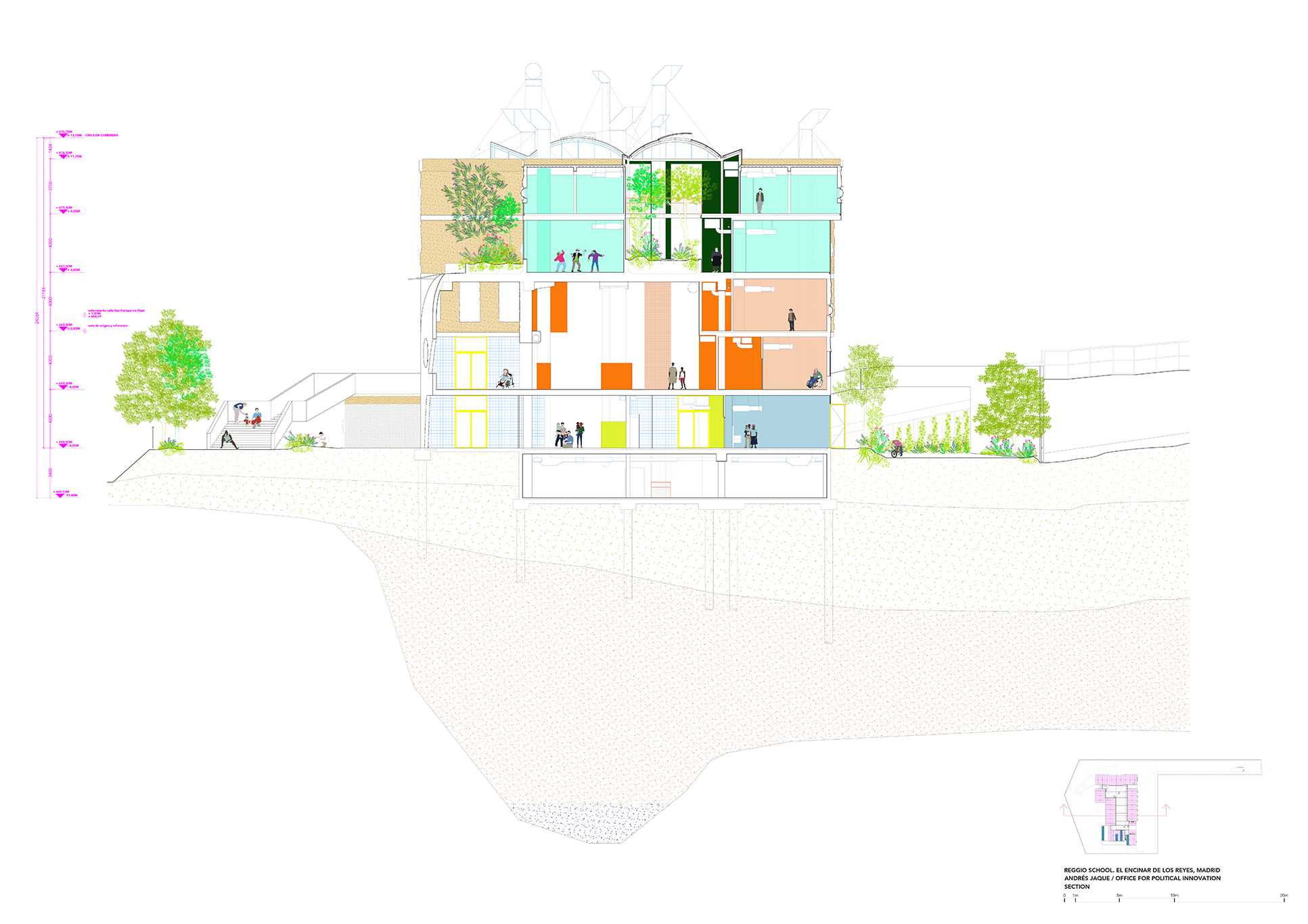
完整项目信息
Calle San Enrique de Ossó, 48. El Encinar de los Reyes, 28055 Madrid 59,158.45 sq. ft.
Architects: Andrés Jaque / Office for Political Innovation
Team: Roberto González García, Luis González Cabrera, Alberto Heras, Ismael Medina Manzano, Jesús Meseguer Cortés, Paola Pardo-Castillo, Rajvi Anandpara, Juan David Barreto, Inês Barros, Ludovica Battista, Shubhankar Bhajekar, Elise Durand, Drishti Gandhi, Maria Karagianni, Bansi Mehta, Alessandro Peja, Meeerati Rana, Mishti Shah, Saumil Shanghavi
Structural Engineering: Iago González Quelle, Víctor García Rabadán (Qube Ingeniería de Estructuras)
Services Engineering: Juan Antonio Posadas (JG Ingenieros)
Quantity Survey (Project): Javier González Nieto, Javier Mach Cestero (Dirtec Arquitectos Técnicos)
Ecology and Edaphology: Jorge Basarrate, Álvaro Mingo (Mingobasarrate)
Project Management: Ángel David Moreno Casero, Carlos Peñalver Álvarez, Almudena Antón Vélez
Photography: José Hevia
版权声明:本文由Andrés Jaque / Office for Political Innovation授权发布。欢迎转发,禁止以有方编辑版本转载。
投稿邮箱:media@archiposition.com
上一篇:杭州运河万科中心C区:产业建筑的开放姿态 / HCD上海汇乘设计
下一篇:非常建筑新作:从空间原型,到四栋“坊宅”